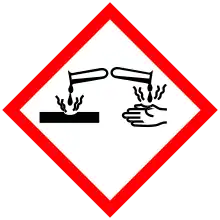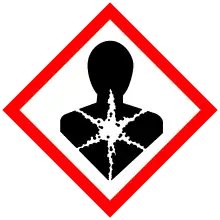Zinc arsenide
Zinc arsenide (Zn3As2) is a binary compound of zinc with arsenic which forms gray tetragonal crystals. It is an inorganic semiconductor with a band gap of 1.0 eV.[2]
| Names | |
|---|---|
| Other names
trizinc diarsenide | |
| Identifiers | |
3D model (JSmol) |
|
| ChemSpider | |
| ECHA InfoCard | 100.031.338 |
| EC Number |
|
PubChem CID |
|
CompTox Dashboard (EPA) |
|
| |
| |
| Properties | |
| Zn3As2 | |
| Molar mass | 345.984 g/mol |
| Appearance | Silver grey[1] |
| Density | 5.53 g/cm3[1] |
| Melting point | 1,015 °C (1,859 °F; 1,288 K) |
| Insoluble[1] | |
| Structure | |
| Tetragonal | |
| Hazards | |
| Safety data sheet | [1] |
| GHS pictograms |    |
| GHS Signal word | Danger |
| H301, H331, H350, H410 | |
| P201, P202, P222, P231+232, P261, P264, P270, P271, P273, P280, P281, P301+310+330, P304+340, P308+313, P321, P370+378, P391, P403+233, P405, P422, P501 | |
| NFPA 704 (fire diamond) | |
Except where otherwise noted, data are given for materials in their standard state (at 25 °C [77 °F], 100 kPa). | |
| Infobox references | |
Synthesis and reactions
Zinc arsenide can be prepared by the reaction of zinc with arsenic
- 3 Zn + 2 As → Zn3As2
Structure
Zn3As2 has a room-temperature tetragonal form that converts to a different tetragonal phase at 190°C and to a third phase at 651°C.[3] In the room-temperature form, the zinc atoms are tetrahedrally coordinated and the arsenic atoms are surrounded by six zinc atoms at the vertices of a distorted cube. The crystalline structure of zinc arsenide is very similar to that of cadmium arsenide (Cd3As2), zinc phosphide (Zn3P2) and cadmium phosphide (Cd3P2). These compounds of the Zn-Cd-P-As quaternary system exhibit full continuous solid-solution.[4]
Electronic structure
Its lowest direct and indirect bandgaps are within 30 meV or each other.[2]
References
- "LTS Research Laboratories, Inc. Safety Data Sheet: Zinc Arsenide" (PDF). ltschem.com. Retrieved 2020-10-26.
- Botha, J. R.; Scriven, G. J.; Engelbrecht, J. A. A.; Leitch, A. W. R. (1999). "Photoluminescence properties of metalorganic vapor phase epitaxial Zn3As2". Journal of Applied Physics. 86 (10): 5614–5618. doi:10.1063/1.371569.
- Okamoto, H. (1992). "The As-Zn (arsenic-zinc) system". Journal of Phase Equilibria. 13 (2): 155–161.
- Trukhan, V. M.; Izotov, A. D.; Shoukavaya, T. V. (2014). "Compounds and solid solutions of the Zn-Cd-P-As system in semiconductor electronics". Inorganic Materials. 50 (9): 868–873. doi:10.1134/S0020168514090143.

